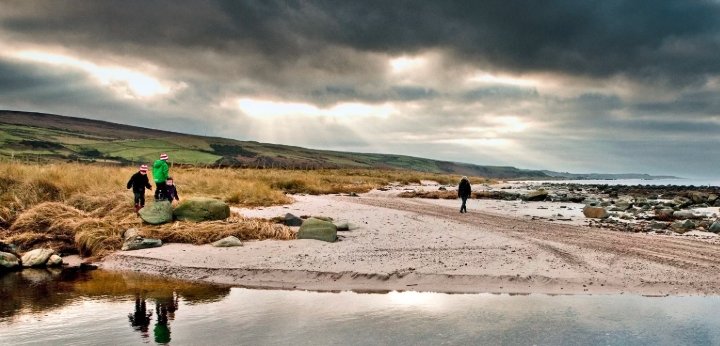A new framework promising to reshape how Scotland approaches the climate crisis — and who benefits from it — has just been released. And it’s not just about cutting emissions. It’s about changing the system.
Published by the Stockholm Environment Institute (SEI) on June 24, the “Unlocking a Better Future” framework lays out a detailed approach to delivering a just transition in Scotland — one that’s fair, forward-thinking, and fundamentally different from business as usual.
It’s Not About Fixing One Problem — It’s About Fixing the Whole Setup
Forget the idea that we can just switch to electric cars and call it a day. The authors — Fiona Lambe, Nina Weitz, Annika Hilgert, and Eric Kemp-Benedict — argue that Scotland needs a system-wide transformation. Think: economy, energy, labour, governance — all reimagined together.
At the heart of the report is a core belief: you can’t fix climate change without fixing inequality. And you can’t fix inequality with disconnected policies.
Their “Unlocking a Better Future” (UBF) framework does three big things:
-
Identifies key leverage points in the system that could shift Scotland toward more equitable climate action
-
Maps systemic gaps, showing where current efforts fall short
-
Lays out joined-up recommendations, informed by government consultation and SDG (Sustainable Development Goal) tools
One sentence here: It’s like Google Maps for climate justice — but with detours, barriers, and intersections clearly marked.

This Isn’t Just Theory — It’s Been Road-Tested in Scotland
Unlike many academic blueprints that sit in digital drawers, this one’s already been put to work.
SEI researchers worked directly with the Scottish Government policy team, as well as a broad mix of stakeholders, to ensure the findings weren’t just idealistic — but actually usable. Policy workshops, consultation sessions, and SDG synergy mapping were central to the process.
The SDG Synergies tool, in particular, allowed teams to see the relationships between different goals — what supports what, and what clashes. And that matters, because without that kind of thinking, well-meaning climate action can backfire.
Example? You might push for green infrastructure, but if you don’t build in labour retraining, workers in old sectors could be left behind. Trade-offs matter.
One-line takeaway: joined-up thinking means fewer policy contradictions — and fewer people left out.
What Does the Framework Recommend?
So, what are we actually talking about? The UBF framework produced a roadmap for transformation — one that tries to balance environment, economy, and equity.
Here’s a taste of what’s in the report:
-
Strengthen community-led climate action, including more direct investment in local energy and transport
-
Redesign public procurement to favour low-carbon suppliers and worker cooperatives
-
Embed long-term planning in climate policy, beyond election cycles
-
Prioritize inclusive decision-making, especially with trade unions, rural voices, and youth
-
Support economic diversification in oil and gas regions before decline accelerates
It also pushes the government to address structural inequalities — not as a side effect of climate policy, but as a goal in itself.
Beyond Scotland: Could This Work Elsewhere?
The report’s authors think so. They argue that the framework is adaptable, not just to other UK nations, but to any region trying to balance decarbonization with fairness.
“Other countries can adopt this framework,” says co-author Nina Weitz. “It gives structure to something governments often struggle with — turning climate ambition into cohesive, fair, long-term plans.”
One big difference between this and other just transition models? It explicitly incorporates feedback loops, systemic analysis, and trade-off planning at the start — not as afterthoughts.
Here’s how it stacks up compared to standard transition planning:
| Feature | Traditional Transition Plans | UBF Framework (Scotland) |
|---|---|---|
| Focus on emissions cuts | Yes | Yes, but with equity built-in |
| Trade-off analysis | Often missing | Core feature (via SDG tool) |
| Community consultation | Varies | Central to process |
| Multi-sector integration | Weak | Strong |
| Legacy systems analysis | Often skipped | Prioritized |
This structure allows for a dynamic transition, one that evolves with political, social, and economic feedback — not a static checklist that goes stale in two years.
Why It Matters Now — And Why It’s Not Just Another Report
The timing isn’t random. Scotland is at a crossroads. With North Sea oil under pressure, net zero targets under scrutiny, and growing unrest over inequality, there’s no time for piecemeal plans.
This framework offers something rare: a shared map that can bring civil servants, activists, academics and industry to the same table.
And crucially, it gives policy legitimacy — because it was created through real engagement, not just academic modelling.
“This isn’t about ticking boxes,” said one Scottish policy adviser familiar with the work. “It’s about making sure we don’t solve one crisis by making another worse.”
Scotland’s Just Transition Commission has already endorsed parts of the approach, and climate campaigners say it gives them something solid to point to when demanding action that goes beyond slogans.
One last thought: real transitions aren’t clean, fast, or easy. But frameworks like UBF at least give you a fighting chance of getting it right — before the window closes.


















